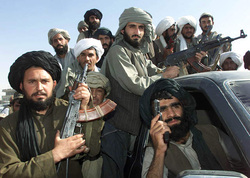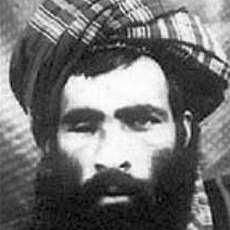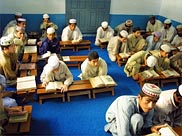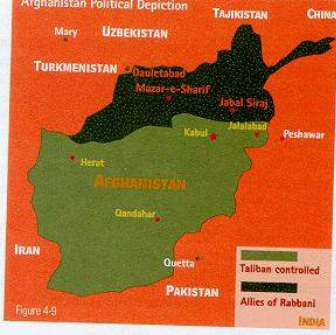The origin of the Taliban
Table of contents

- What is the Taliban?
- The leader of the Taliban
- The Islamic religious schools
- The development of the Taliban
- Sources
What is the Taliban?
There are two different statements about the identity of the Taliban. The one is that the Taliban are a Pashtun (an ethic group) nationalist movement, or militant Islamic fundamentalist movement and also are part of global jihadism which focuses on armed jihad(holy war; resistance to alien occupation) and radical Islamic fundamentalism). Another one is that the Taliban is the Islamic militant group which conduct those movements above. They do not merely symbolize Pashtun nationalism but they also stand for the simplicity and extreme conservatism of 7th century Islam. The Taliban is not a new force in terms of history and the ideas of Taliban stem from the veterans of Mujahideen (the jihadists who coped with the Soviet invasion). It emerged from the religious schools and the people in the Taliban militia (basically students from Islamic religious schools in Pakistan) live a miserable life without amenities.The dominating Pashtun Taliban emerged made up of taliban militia in the year of 1994. It is the 20 years' invasion of the Soviets and civil wars that indirectly help to materialize the Taliban and caused more than 1.5 million the deaths of people as well as devastated the country.
The leader of the Taliban

Mohammad Omar, also called Mullah Omar, has been the head of the Taliban for over 15 years and was the ruler of Afghanistan itself from 1996 to 2001. When the Soviets intruded into Afghanistan, he became a part of Mujahideen. After the withdrawal of the Soviets in the late 1980s, he decided to take over political and military power of Afghanistan and set into action with less than 50 armed students. Finally he wielded tremendous clout in Afghanistan in 1996.
Mohammad Omar
Mohammad Omar
The Islamic religious schools

The pivotal goal of the Madrasas (Islamic religious schools) is to teach the students the Islamic theology and the importance of a jihad to create an Islamic government. The teachers in the religious schools are known as ulema. They not only encouraged the wars against the Soviets but they advocate fighting against any intrusive force. After fighting off the Soviets and the downfall of communist regime in Kabul, most of the ulema returned to the religious schools to nurture the new generation of the Taliban. The ulema shifted the blame of
The Madrasas
reconstructing the country and establishing stable social order to Mujahideen. Also, the rest of the ulema still play an significant role in the Mujahideen Party. The majority of the Taliban militia consist of students who haven’t completely fulfilled the religious training yet. Not receiving a well-rounded education, they regard anything exotic as a type of aggression and want to shape the whole world based on their values and world views. The characters of the Taliban militia, such as rigidity, puritanism, have been molded by the lack of time with their families in their childhood, which is caused by the wars. And they are fanatical about jihad, masculinity, and the glorification of martyrdom.
The Madrasas
reconstructing the country and establishing stable social order to Mujahideen. Also, the rest of the ulema still play an significant role in the Mujahideen Party. The majority of the Taliban militia consist of students who haven’t completely fulfilled the religious training yet. Not receiving a well-rounded education, they regard anything exotic as a type of aggression and want to shape the whole world based on their values and world views. The characters of the Taliban militia, such as rigidity, puritanism, have been molded by the lack of time with their families in their childhood, which is caused by the wars. And they are fanatical about jihad, masculinity, and the glorification of martyrdom.
The development of the Taliban
The war between the Soviets and Afghanistan facilitated the formation of refugee camps in Iran and Pakistan, and the widows and orphans who were left behind and children did not receive the education they deserved. However, compared to refugee camps, the religious schools became a much superior place to live. All sorts of services as well as education, were offered, such as medical care, housing and foods and these services were accessible to all the refugee students. The scale of refugee camps was extended under the support of governments and state policies, which resulted in the flooding in of more children who have a chance of being a part of the Taliban militia. Then the chaotic situation of corruption, worsening law and order, division of country, continuous civil war between Pashtuns in the south or east and ethnic minorities—Tajik, Uzbek, Hazara, and the Turkmen in the north—provoked the ulema and the Taliban to overthrow the political reign of Mujahideen leadership. They launched the campaign from the suburban areas of Kadahar in 1994. The Taliban were aware of the fact that native citizens had turned against the Mujahideen rulers. They were popular with Pashtuns who were weary of unceasing civil wars for their slogans of establishing social stability, security, justice and Islamic laws. The Taliban had all kinds of competitive advantages as they constantly seized one site after another without too much resistance. The Taliban strengthened their power while they were on their way to Kabul. The small snowball eventually became a big one when they effectively captured Kabul in 1996. Since then, the Taliban seemed to lose interests in taking hold of the political power of the country and were intigated by their Pakistan and Saudi backers as well as Osama Bin Laden to conquer more than Afghanistan.
Sources
1.Rais, R. B. (n.d.). Conflict in Afghanistan: Ethnicity, Religion and Neighbour. Retrieved September 25, 2011, from http://ices.lk/publications/esr/articles_jan99/Afghanistan-%20Rais,ESR,Jan%201999.pdf
2.Rashid, A. (n.d.). Taliban: Islam, Oil and the new great Game in central Asia. Retrieved September 25, 2011, from http://books.google.com/books?hl=en&lr=&id=kIBgqHWq658C&oi=fnd&pg=PR9&dq=taliban&ots=jXlXCPVkr_&sig=a2cq7_owgY8R9nawA3qIz3STsPQ#v=onepage&q&f=false
3.Rashid, A. (n.d.). The Taliban: Exporting Extremism. Retrieved September 25, 2011, from http://www.jstor.org/sici?sici=0015-7120%281999%2978%3A6%3C22%3ATTEE%3E2.0.CO%3B2-Q&origin=openly;oclc;worldcat.org4
4.Ahrari, E. (n.d.). China, Pakistan, and the "Taliban Syndrome". Retrieved September 25, 2011, from http://www.jstor.org/sici?sici=0004-4687%282000%2940%3A4%3C658%3ACPAT%22S%3E2.0.CO%3B2-O&origin=openly;oclc;worldcat.org
5.Berlatsky, N. (2011). The Taliban. N.p.: Detroit : Greenhaven Press.
2.Rashid, A. (n.d.). Taliban: Islam, Oil and the new great Game in central Asia. Retrieved September 25, 2011, from http://books.google.com/books?hl=en&lr=&id=kIBgqHWq658C&oi=fnd&pg=PR9&dq=taliban&ots=jXlXCPVkr_&sig=a2cq7_owgY8R9nawA3qIz3STsPQ#v=onepage&q&f=false
3.Rashid, A. (n.d.). The Taliban: Exporting Extremism. Retrieved September 25, 2011, from http://www.jstor.org/sici?sici=0015-7120%281999%2978%3A6%3C22%3ATTEE%3E2.0.CO%3B2-Q&origin=openly;oclc;worldcat.org4
4.Ahrari, E. (n.d.). China, Pakistan, and the "Taliban Syndrome". Retrieved September 25, 2011, from http://www.jstor.org/sici?sici=0004-4687%282000%2940%3A4%3C658%3ACPAT%22S%3E2.0.CO%3B2-O&origin=openly;oclc;worldcat.org
5.Berlatsky, N. (2011). The Taliban. N.p.: Detroit : Greenhaven Press.

